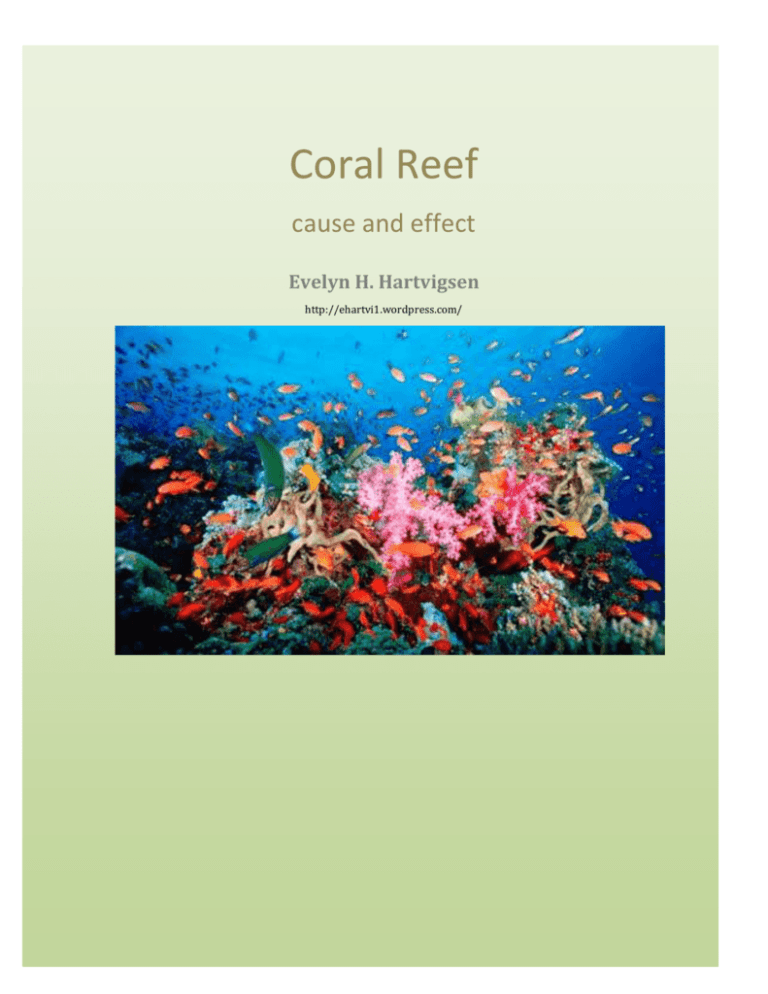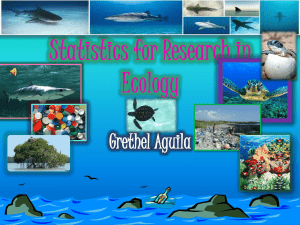Coral Reef Alliance
advertisement

Coral Reef cause and effect Evelyn H. Hartvigsen http://ehartvi1.wordpress.com/ Coral Reef, a living building block just under the oceans surface. Coral, by definition is “the hard, variously colored, calcareous skeleton secreted by certain marine polyps” (Dictionary.com). A reef is “a strip or ridge of rocks, sand, or coral that rise to or near the surface of a body of water” (Dictionary.com) together you have a living colony taking care of itself and other species. Coral Reefs are a benefit in many ways. It is a living organism, an animal, which supports thousands of other organisms. Many species live on or in a coral reef, using it as a home and for nutrients. Coral Reefs are not only life sustaining for species living in the sea but outside of it as well. A healthy coral reef can be a great tourist attraction due to their interesting shapes and beautifully colored polyps. Polyps are the individual coral, which are themselves ancient animals related to jellyfish (Basic Facts About Coral Reefs/Defenders of Wildlife). Fishing in these areas is also an activity that local humans survive off of. They use it not only to feed themselves, but for tourist fishing and a worldwide demand of fresh fish. Thereby bringing financial support to the area. However the lasting effects caused by the over use of both of these activities are only a drop in the bucket of the problematic situations the world’s coral reef populations face. Over fishing an area not only depletes the species of fish, but also takes away the grazers who would help keep algae at a low level. Populations of grazing fish eat the algae that grow on the coral reef, which then enables the coral to Figure 1 Healthy coral vs. Bleached coral thrive and not be over grown. (National Center for Ecological Analysis and Synthesis). And too much human interaction in any natural environment can cause issues. Sometimes these issues are caused by accident such as: coral damage and/or contamination of an area. Another challenge to the survival of a coral reef is bleaching (Figure 1), “while episodic, it is a major contributor to coral loss” (Ledlie et al., 2007; Mumby, 2009b). Bleaching is a response to stress, or change in environment. The coral dies and loses its color, turning white. It is hard to define the exact causes of this reaction due to several overlapping factors, but temperature change is a large contributor. There have also been cases of Solar Irradiance, which is a bleaching due to seasonal temperature change. A change in tide patterns, such as a low tide, can leave a once covered coral reef exposed to more sunlight and heat linking it to the bleaching effect. This occurrence is called a subaerial exposure. There has been a very noticeable amount of bleaching taking place since the 1980’s, be it human caused or natures way of adapting and evolving it has taken its toll on the reefs around the world. Coral Reefs also face freshwater dilution; this takes place during times of severe weather. With large gusts of wind causing displacement of the ocean water, and large amounts of fresh rainwater taking its place, the chemical make up of the ocean water changes and causes the biological makeup of the coral to become unstable. Instability can create an atmosphere for disease and the corrosion or death of the coral and all the life that survive with it. Some say that global warming is responsible for many of the environmental woes of the modern day. There are studies detailing that mankind’s way of life has had devastating effects on the climate around us. Not everyone agrees, so more and more studies are done, not only to understand but also to inform and hopefully enlighten us. What is the best way to deal with, or stop this deterioration, is there a way? One such study shows that deforestation is a huge influence in the changes we are seeing in the ocean. In historical records signs of the decay of the coral reefs in the Caribbean are shown in the beginning of the 1900s. This was during the time period that many coastal areas were being cleared for plantations. The belief being that less trees equals more carbon dioxide in the air. The ocean absorbs the carbon dioxide like a sponge, which has been good for the surface above the ocean; it has helped reduce greenhouse gas levels in the atmosphere. This change however has greatly affected all life in the ocean; the sizes of species like oysters and clams have shrunk. Different types of coral, once dominant, have become recessive. Branching coral has shifted to non-branching coral, there by not able to spread out and increase its volume (Ecology Letters, journal and research funded by the National Science Foundation the Smithsonian Institution, the Center for Marine Biodiversity and Conservations at Scripps). The higher amounts of carbon dioxide in ocean water, the lower the potassium hydrogen level. This decrease in seawater pH wreaks havoc with the ability of sea life to form correctly; organisms are unable to develop their shell, which has been called “ocean acidification” (Coral Reef Alliance; Threats to coral reefs). A second side effect of deforestation is the pollutants that are discarded in the ocean. When land is cleared along a coast line the debris has to go somewhere, at times the left over, torn up earth including dirt, trees, rocks, sticks, all end up in the ocean. This action causes stress on the life forms surviving below the surface of the water, again adding to an already stressed situation. The damage that is done in the beginning by overfishing, polluting the environment, dumping, cutting, basically pillaging and plundering, comes full circle. Less coral reefs equal less marine life, which in turn affects tourism, financial stability, food supply, species survival, and the fragile state that the earth is already in. The damage that has been done cannot be reversed, but it can be slowed. Changes in laws, controlling pollution, better kept fishing habits, planting trees, all steps to adapt to our always evolving world. Coral reefs make up less than 1% of marine environment but they are home to 25% of the ocean’s marine life, that is a lot to take care of in a small space. Any damage at all is not acceptable, even the smallest amount of change can end a species, and/or a way of life. If this much damage is apparent through historical data and study, how much more damage or proof will there have to be before something is done to stop it? References Cover http://www.theguardian.com/environment/2011/feb/23/coral-reef-report-dying-danger Figure 1 - http://sunscreenpollution.blogspot.com/2013/04/what-is-issue-in-2013-americancancer.html Figure 2 -http://www.theguardian.com/environment/2011/feb/23/coral-reef-report-dyingdanger Coral Reef Alliance Defenders of Wildlife Ecological Modelling: journal –Carlos Ruiz Sebastian a,b, * Timothy R. McClanahan a – Ledlie et al., 2007, Mumby, 2009b National Science Foundation, the Smithsonian Institution, the Center for Marine Biodiversity and Conservation at Scripps National Center for Ecological Analysis and Synthesis University of Miami Rosenstiel School of Maine & Atomospheric Science (2011, May 30)






